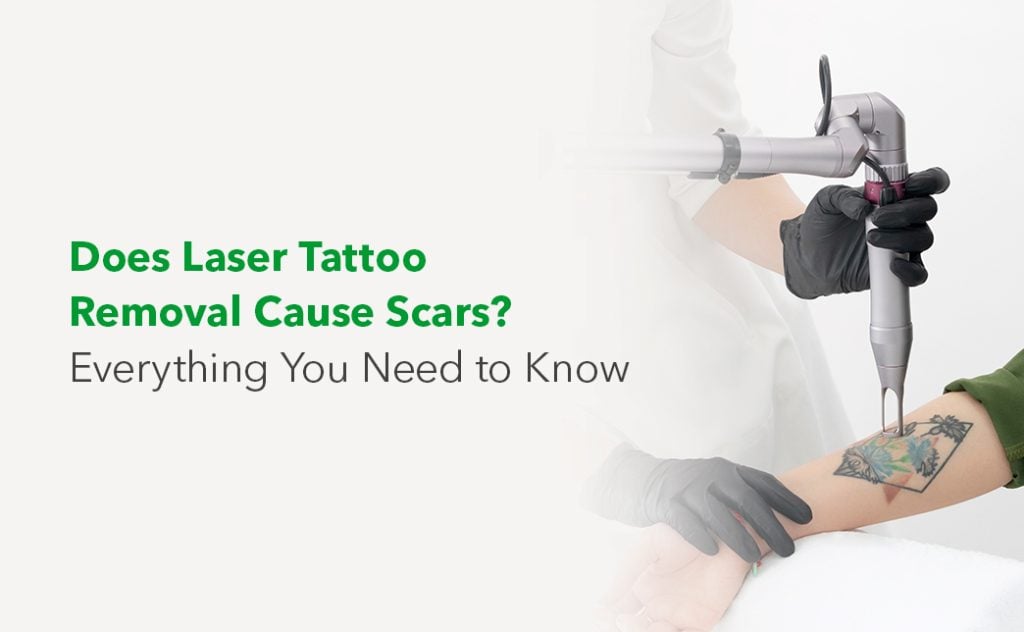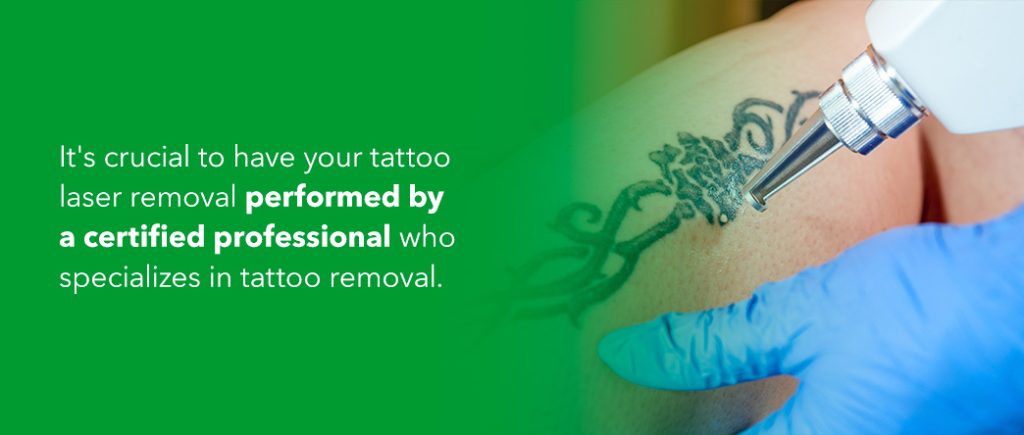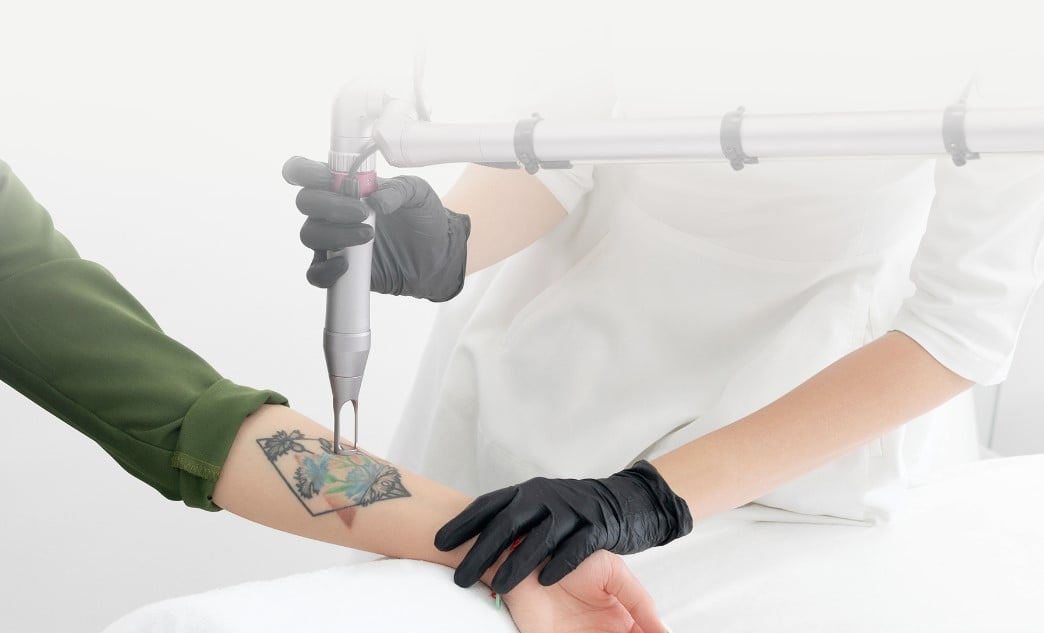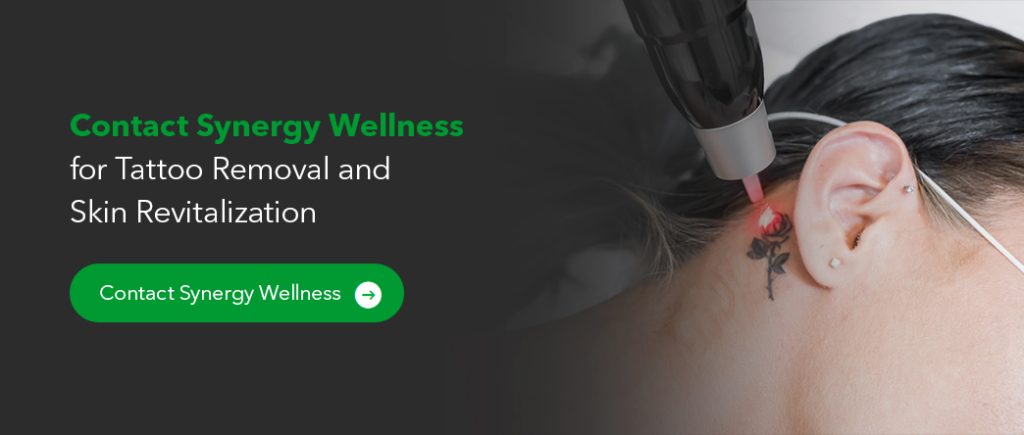
People love getting tattoos, whether to commemorate an event, honor someone, show love toward something or just because. While tattoos are an excellent form of self-expression, some people regret getting their tattoos or simply don’t want them on their bodies anymore.
The good news is tattoo laser removal can help you start over, eliminating the ink in your skin. However, many people worry about laser tattoo removal scars. Below, you’ll learn everything you need to know about the potential for scarring and how you can prevent it from happening.
Does Laser Tattoo Removal Leave Scars?
While tattoo removals can leave scars, tattoo removal scars are uncommon. Still, they can happen, and you may even notice scars left behind from your tattoo when you get it removed.
If your skin has irregularities, such as existing scars, you can expect these to remain after the laser removal. Some tattoos can leave scarring if your artist pushes the needle too far into your skin during your session, which can cause these scars to remain after your laser removal. You may not see these scars until your removal is complete.
Failing to follow the aftercare instructions after your laser removal can also cause tattoo removal scars. You must keep the treated area clean and covered while you’re healing. Otherwise, you could increase your risk of developing an infection, which can cause scarring. Picking at the site can also cause scars, so avoiding touching the area is the best way to reduce your risks of scar development.
Remember that tattoo removal will require multiple sessions. If you try to remove your entire tattoo in one go, the risk of scarring after laser tattoo removal increases. Removing something that was meant to be permanent will take time, so practice patience to get the best results from your treatment.
What Are the Chances of Scarring From Laser Tattoo Removal?
One study indicates that between 18.8% to 25% of tattoo removals scar. If you work with a certified professional, they’ll curate your treatment plan and choose the appropriate intensity to help remove your tattoo as quickly as possible while reducing your risk of scarring.
While the chance is relatively low, it’s still essential to be aware of scarring as a potential side effect. There are other possible side effects you should be mindful of before getting your laser tattoo removal, such as:
- Discoloration
- Blistering
- Scabbing
- Crusting
- Infections
- Allergic reactions
Not every person will experience these side effects. Some people won’t encounter any side effects at all. In many cases, scabs and blisters can be a sign of healing, especially because scabs protect the treatment area from potential infection. Taking care of the treatment site and following aftercare instructions will significantly reduce your risk of developing an infection and scars.
How to Prevent Scarring From Tattoo Removal

While tattoo removal doesn’t often cause scarring, many people still want to do everything they can to prevent it from happening.
First, it’s crucial to have your tattoo laser removal performed by a certified professional who specializes in tattoo removal. Removing the tattoo at home or through an uncertified program can significantly increase your risk of scarring because you’re not working with professionals who know the ins and outs of tattoo removal.
The next thing to know is you’ll likely require multiple sessions, and as your body starts healing from the first session, you might develop blisters or scabs. It’s essential not to attempt to pop these blisters or pick at the scabs since doing so can increase your risk of scarring. Keep the area clean and covered while it’s healing to reduce the risk of infection.
There are additional ways you can prevent scarring, including:
- Staying hydrated: Drinking plenty of water helps keep your body in good health. Staying hydrated helps improve your blood circulation, which increases white blood cell count and encourages healing. Remember to drink plenty of water after treatment to boost your immune system.
- Stopping smoking: Smoking affects your immune system, making it harder for your body to heal and making you susceptible to infections. If you smoke, it’s best to wait until your body has completely healed from your treatment to continue. You can even use your treatment as an opportunity to quit smoking altogether to improve your overall health.
- Wearing sunscreen: While the area of your skin is undergoing treatment, it’s essential to protect it from ultraviolet (UV) rays that can impact your healing and cause scarring or hyperpigmentation. Wear sunscreen or clothing over the healing area while you’re out in the sun until it’s completely healed.
Do Tattoo Removal Scars Go Away?
As mentioned, it’s uncommon for tattoo removals to leave scars when performed by a professional at the correct intensity. Sometimes, people will notice a scar after their removal, though the scar is often from the tattoo, where the artist penetrated too deeply into the skin. These scars are sometimes hard to notice until the tattoo is removed. Some scars may fade over time, while others can become permanent.
In some rare cases, a person might experience discoloration or hypopigmentation from the removal process as a side effect. This effect usually appears as the area where the tattoo used to be is lighter than the surrounding skin. Discoloration can occur from improper aftercare or working with an inexperienced technician. It’s not the same as scarring, but hyperpigmentation can take a long time to disappear, or it can be permanent.
What to Do if Tattoo Removal Leaves Scars
Some scars will heal independently with time, but it can be challenging to tell which scars will go away and which are permanent. Some people get keloid scarring after tattoo removals, a scar appearing after an injury. People who have had keloid scars are more likely to have one again from an injury, including tattoo removal.
There are ways to eliminate scarring or get a scar to fade, though some scars will remain, even if they’re not as severe as they once were. Some of these methods include:
- Additional laser treatments: If you get keloid scars, you can also treat these through laser removal to reduce their appearance. You’ll have to consult a dermatologist to ensure your scar is a keloid scar, and they can help determine the best treatment.
- Microdermabrasion: This technique utilizes chemical scrubs that remove the top layer of skin, which can help create a smoother appearance and skin tone. You can try microdermabrasion to help reduce the appearance of your scars.
- Scar ointment: Some people use scar-fading creams to help reduce the appearance of their scars. If you choose this option, it’s essential to wear sunscreen while using the ointment to prevent the scar from darkening.
- Aloe vera: Aloe vera has unique skin-healing properties, especially for wounds and burns. You can try applying aloe vera on your scar to reduce its appearance.
- Moisturizer: Moisturizer won’t remove scars, but it can help keep the area hydrated, which will help make it less noticeable.
Remember that these methods might not eliminate scarring but can help the scar fade until it’s less noticeable. The best bet is to work with an experienced professional for your tattoo removal to decrease your risk of scarring in the first place.
Contact Synergy Wellness for Tattoo Removal and Skin Revitalization
If you have a tattoo you regret or have simply outgrown, Synergy Wellness is here to help. We offer tattoo removal services that utilize modern laser technology to help remove the ink from your skin while protecting it from damage. We can remove tattoos of all kinds, regardless of size, color or location. Our laser technology breaks up the ink quickly and effectively, ensuring you receive lasting results.
If you’re ready to get rid of an unwanted tattoo, contact Synergy Wellness to learn more about our tattoo removal services and how we can help bring back your confidence!




